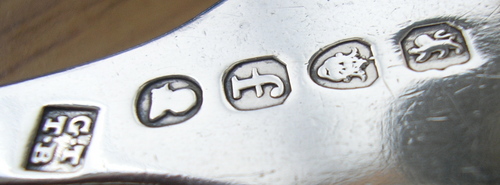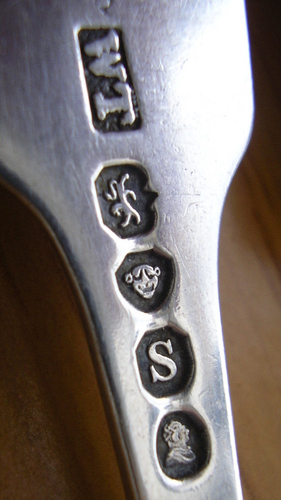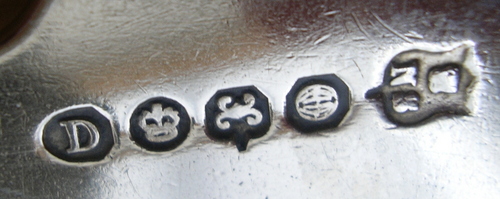Got a load of forks , spoons etc , and the more I try to identify marks the more confused I get , can anyone point me in the right direction please ? Everytime I get close to identifying a mark , something tells me its not correct ? What do you think about these marks please ?



Hi Pete, welcome to silver-collector.com.
The first two marks are sterling silver marks, and the last mark is a silver plate mark. The top image shows the marks for London (the leopards head with a crown), the date letter f for 1821, and the makers mark for George Turner and Thomas Biddell.
The second image shows the marks for London (the leopards head but this time uncrowned), the date letter S for 1833, and the makers mark for William Troby.
The final mark is a Victorian silver plate mark but I do not recognise it, although it must be pre 1892 as it isn’t stamped EPNS or EP so thats a good indication of age.
The best resource for indentifying, and learning how to identify hallmarks is Bradburys book of Hallmarks. It is the bible for anyone interested in reading silver hallmarks, and is very easy to use.
Hope that helps a bit, do let me know if i can help further.
Daniel
Hi Daniel ,
Thanks alot for your help . I was working along the right lines but the marks seem to vary so much from the ones in the guidebooks and on the net
.For instance I could not find the leopards head with the eyes shaped like the one in the pic . And how important is the shape of the stamp ? Shield , square, etc. as outer shape . All very confusing but you have cleared a few things up for me , thanks again , I will get there !
I am struggling with a few more marks but have got that book on order so will look at that first .
Peter
Hi Peter,
The shape of the shield is critical, but the exact details of the mark (for instance eye shape) are not so important.
Remember that there were stamps of varying sizes for different size pieces. The marks on flatware are the smaller type and might have less details than marks on a larger item, like a tray.
Also, as the hallmarks were hand punched onto the item, there is some variation in the strength of the marks Also you might find marks where the punch bounced or slipped.
Finally, the punches themselves were hand made and deteriorated with use.
I’ll finish as I began, shield shape is critical. This is true for the sterling mark as well as the town and date marks.
Regards // Jonathan